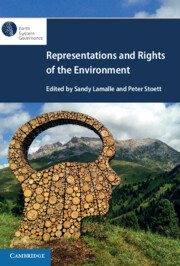Book contents
- Representations and Rights of the Environment
- Series page
- Representations and Rights of the Environment
- Copyright page
- Dedication
- Epigraph
- Contents
- Illustrations
- Tables
- Contributors
- Preface
- Acknowledgements
- 1 An Introduction
- Part I Challenges
- 2 Environmental Humanities
- 3 Decolonising the Dialogue on Climate Change
- 4 Our Relationship with the Land
- 5 A Common Space of Legal Communication
- Part II Recollection
- Part III Perspectives
- Index
- References
4 - Our Relationship with the Land
An Ecology of Perception
from Part I - Challenges
Published online by Cambridge University Press: 16 March 2023
- Representations and Rights of the Environment
- Series page
- Representations and Rights of the Environment
- Copyright page
- Dedication
- Epigraph
- Contents
- Illustrations
- Tables
- Contributors
- Preface
- Acknowledgements
- 1 An Introduction
- Part I Challenges
- 2 Environmental Humanities
- 3 Decolonising the Dialogue on Climate Change
- 4 Our Relationship with the Land
- 5 A Common Space of Legal Communication
- Part II Recollection
- Part III Perspectives
- Index
- References
Summary
How do we perceive the rest of nature meaningfully from the vantage point of our manufactured spaces? Whether the life teeming in a tropical forest, or surviving tenaciously on the remote reaches of the planet, we impact life that we probably never see first-hand. Our impact is from the manifestation of our nature, which is creative, industrious and prolific. Unfortunately, our impact threatens the stability of the only biosphere we can call home. How can human nature be connected to instead of orphaned from the rest of nature? No matter how much data we acquire about the crises we create for ecosystems, there remains tremendous inertia to apply the principal remedy: changing our behaviour. This implies the necessity to expand our focus from quantitative deduction of the problem and solutions, to ensuring we have the inner connections and relationships necessary for qualitative response to environmental stress. Does art create this sensitive bridge?
Keywords
- Type
- Chapter
- Information
- Representations and Rights of the Environment , pp. 87 - 109Publisher: Cambridge University PressPrint publication year: 2023
References
Primary Sources
Secondary Sources
- 1
- Cited by

